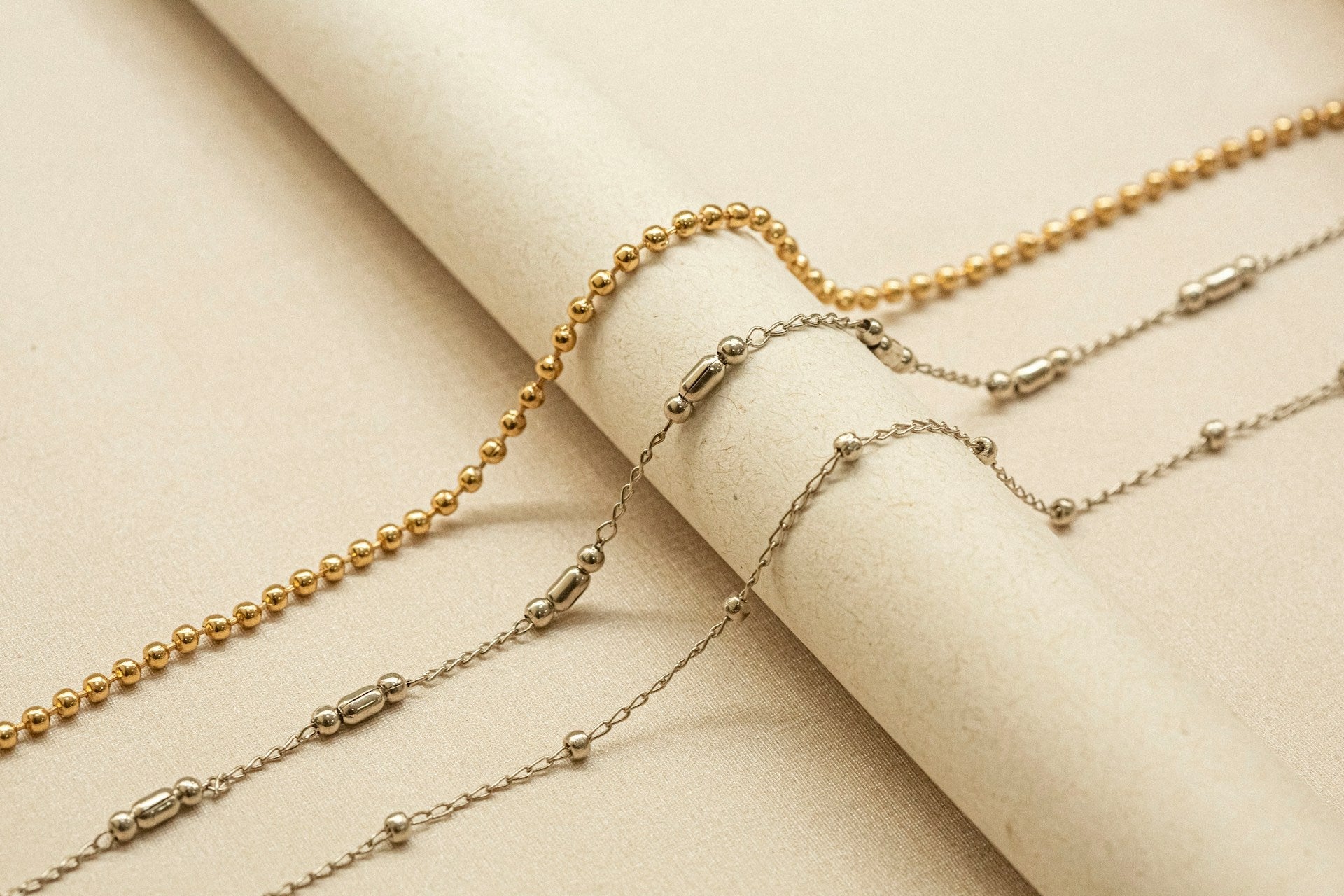Precious Metals Guide: Jewellery Selection Tips & More

Jewellery has dazzled us for centuries, adorning wrists, necks, ears, and fingers with shimmering splendour. But what makes jewellery truly shine are the metals used in crafting these beautiful pieces. Each metal comes with its own unique story, offering different looks, feels, and qualities.
Understanding the metals in jewellery can help you make the right choice for any occasion—be it a wedding, birthday, or just because you want to treat yourself. From the timeless glow of gold to the modern appeal of titanium, each metal has its distinct characteristics.
Join us as we dive into the world of jewellery metals. Whether you're already a fan of certain metals or you're curious about trying something new, this guide will help you discover the best fit for your style and needs.
Exploring Classic Metals: Gold, Silver, and Platinum
Gold, silver, and platinum have long been favourites in jewellery-making. They are prized for their beauty, versatility, and timeless appeal. Each has unique qualities that make it special, so let’s take a closer look at these classic metals.
Gold is cherished for its rich colour and lustrous shine. It comes in several hues, including yellow, white, and rose gold, achieved by mixing pure gold with other metals. Yellow gold is warm and traditional, while white gold offers a modern look. Rose gold, with its soft pink tint, adds a romantic touch. Gold's durability makes it suitable for everyday wear, and it pairs beautifully with many gemstones.
Silver is loved for its affordable price and bright, shiny appearance. It’s softer than gold and platinum, so it’s often alloyed with copper to create sterling silver, making it stronger. Silver looks elegant on its own or with stones, and its neutral tone makes it easy to match with a wide range of colours and styles.
Platinum features a naturally bright white appearance and is known for its exceptional strength. It’s heavier and rarer than gold and silver, making it a luxurious choice for high-end jewellery. Its durability makes it perfect for securely holding precious stones, and its hypoallergenic nature makes it ideal for sensitive skin.
These classic metals continue to captivate jewellery lovers with their blend of beauty and functionality. They offer foundational choices for creating stunning pieces that can be cherished for generations.
Modern Choices: Titanium and Tungsten in Jewellery
Titanium and tungsten are gaining popularity in jewellery design due to their modern look and superior strength. These metals offer durability and a sleek aesthetic that appeals to those looking for something different. Let’s explore what makes these modern metals stand out.
Titanium is a lightweight metal with a silvery-grey appearance. It is incredibly strong and resistant to scratches, making it perfect for people with active lifestyles. Titanium is commonly used in men's rings and watches, but it’s also growing in women’s jewellery designs. Its hypoallergenic properties make it safe for those with metal sensitivities.
Tungsten, known for its heavy weight and scratch resistance, is another metal making waves in the jewellery world. It’s often chosen for wedding bands due to its enduring properties. Tungsten has a unique, dark grey or black tone, which offers a bold contrast to traditional jewellery metals. Its hardness makes it an enduring option, though it's less flexible than titanium.
Here’s why titanium and tungsten are worth considering:
-
Durability: Both metals resist wear and tear, maintaining their appearance over time.
-
Distinct Look: Their sleek, modern finish appeals to fashion-forward individuals.
-
Low Maintenance: They require minimal care to keep looking new and shiny.
Titanium and tungsten are perfect for those seeking durability and a modern flair in their jewellery. These metals provide exciting alternatives to traditional choices, expanding possibilities for creative and lasting designs.
Affordable Alternatives: Stainless Steel and Brass
Stainless steel and brass offer affordable options in jewellery without compromising on style. These metals are popular for their durability and cost-effectiveness. Let’s explore the benefits and uses of these alternative metals.
Stainless steel is often used in watches, bracelets, and necklaces. It has a sleek, modern appearance and is highly resistant to rust and tarnishing. Its strength makes it ideal for pieces that encounter daily wear and tear. Stainless steel is hypoallergenic, making it a great choice for those with sensitive skin. Because of its affordability, it’s often used in trendy designs and costume jewellery.
Brass features a warm, golden tone similar to gold, making it a popular choice for fashion jewellery. Although it’s less expensive, brass still provides a luxurious look. Many designers prefer brass for creating bold, statement pieces. However, it requires more care as it can tarnish over time. Regular cleaning helps maintain its shine.
Here are some reasons to consider stainless steel and brass:
-
Budget-Friendly: These metals are cost-effective, offering stylish options at lower prices.
-
Variety of Designs: Both metals can be crafted into various designs, from classic to contemporary.
-
Low Maintenance: While stainless steel is easy to care for, storing brass properly and regular polishing can preserve its appearance.
Choosing stainless steel and brass allows for variety in your jewellery collection without a big investment. They enable experimentation with different styles, making it easy to keep up with fashion trends.
Mixing Metals: Creative Combinations for Unique Designs
Mixing metals in jewellery is a fun way to explore personal style and create unique designs. By combining different metal tones, you add depth and interest to your collection. Here's a guide to help you successfully mix metals.
Start by selecting metals that complement each other. Gold and silver are a classic pairing that provides a rich contrast. Rose gold can introduce a warm, pink hue that blends well with other gold tones. When mixing, stick to a common theme or style to maintain a cohesive look.
Layering is a useful technique when mixing metals. Try stacking rings of different metals on one finger or combine necklaces of varying lengths. This creates an interesting visual that draws attention and showcases your creativity.
Consider these tips for successful mixing:
-
Balance Your Look: Make sure there's an even distribution of each metal throughout your jewellery.
-
Use Transitional Pieces: Jewellery that includes multiple metals can tie your look together.
-
Experiment with Textures: Different finishes, like matte with shiny, add more dimension.
Mixing metals is about expressing yourself and trying something new. By blending different metals, you can personalise your jewellery look and make each piece feel special.
Conclusion
Choosing the right metal for your jewellery can enhance your style and meet your needs. Classic metals like gold, silver, and platinum bring timeless elegance, while modern options like titanium and tungsten offer durability.
Affordable alternatives such as stainless steel and brass allow for experimentation without breaking the bank. Mixing metals further expands your creative possibilities, making your collection both diverse and personalised.
Explore the diverse range of metals available at Designs By Sapsee to find the perfect custom jewellery match for your style. Whether you're seeking classic elegance or a trendy twist, our unique designs offer something for everyone.
Discover how mixing and matching metals can transform your personal look into something truly special.
